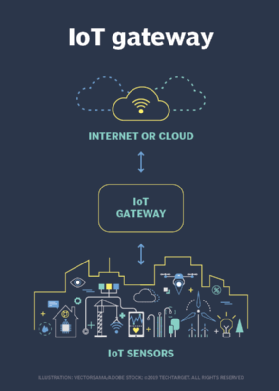IoT gateway
What is an IoT gateway?
An internet of things (IoT) gateway is a physical device or software program that serves as the connection point between the cloud and controllers, sensors and intelligent devices. All data moving between IoT devices and the cloud passes through an IoT gateway, which can be either a dedicated hardware appliance or software program. An IoT gateway might also be referred to as an intelligent gateway or a control tier.
What does an IoT gateway do?
An IoT gateway acts as a network router, routing data between IoT devices and the cloud. Early on, most gateway devices only sent traffic in one direction: from the IoT devices to the cloud. Now, it's common for a gateway device to handle both inbound and outbound traffic. Outbound traffic streams are used for sending IoT data to the cloud, while inbound traffic is used for device management tasks, such as updating device firmware.
Some IoT gateways do more than just route traffic. A gateway device can sometimes be used to preprocess that data locally at the edge before sending it to the cloud. In doing so, the device might deduplicate, summarize or aggregate data as a way of reducing the volume of data that must be forwarded to the cloud. This can have a big effect on response times and network transmission costs.
Another benefit of an IoT gateway is that it can provide additional security for the IoT network and the data it transports. Although they're improving, IoT devices have often been found to be insecure. In 2020, for example, a vulnerability known as Ripple20 was discovered in the TCP/IP library that's used by hundreds of millions of IoT devices, making those devices vulnerable to attack.
One way that an organization can secure its IoT ecosystem is to adopt an IoT gateway that has been specifically designed with features such as tamper detection, encryption, hardware random number generators and crypto engines. These and other features can help to secure an IoT gateway and shield individual devices from attack.
How does an IoT gateway work?
A simple IoT gateway functions similarly to a Wi-Fi router. An IoT system connects to the gateway using a Wi-Fi connection and then the gateway routes the IoT device data to the cloud. More often, though, IoT gateways are far more complex.
One reason why an IoT gateway tends to be more complex than a Wi-Fi router is that there are several different protocols used by IoT devices. Some of these protocols include Z-Wave, BACnet, Bluetooth Low Energy and Zigbee. As such, an IoT gateway might need to support a variety of protocols to service all the IoT devices in an organization.
In addition to supporting these protocols, the gateway must be able to route each type of IoT traffic to the appropriate destination. Data from a collection of industrial sensors might need to be sent to a database in the AWS cloud, whereas data from building security sensors might need to be directed to a SaaS vendor that operates a cloud-based security portal.
Another reason why IoT gateways can be more complex than Wi-Fi routers is because IoT gateways might need to locally cache data in case of an internet outage or in case the gateway is flooded with more data than it can handle.
Additionally, IoT gateways often support failover clustering or the ability to scale out to support increasingly large workloads.
IoT gateways and edge computing
Some IoT devices produce vast quantities of data. This can be a problem if an organization has a significant number of devices in its IoT ecosystem and tries to send the data from all those devices to the cloud. The IoT devices could potentially deplete the organization's available internet bandwidth, while also incurring large cloud storage costs.

One way of avoiding these types of problems is to use edge computing for at least some of the required data processing. This approach reduces the volume of data that must be sent to the cloud, thereby helping to reduce both costs and bandwidth consumption.
Imagine for a moment that an organization has a collection of IP-enabled security cameras, all streaming real-time data. It probably wouldn't make much sense to send all the raw security footage to the cloud for data processing. This is especially true if some of the cameras primarily monitor unoccupied areas.
Rather than uploading all of the security footage in real time, it's more efficient to process the video footage at the edge. The edge device can differentiate between security footage that is unimportant -- such as video of an empty room -- and footage that the organization deems worthy of retention. The edge device can take the footage that must be reviewed and send it to a gateway device, which uploads the data to the cloud.
IoT gateways are important for managing and securing IoT devices, and they might also help an organization to reduce its IoT-related internet bandwidth consumption.







